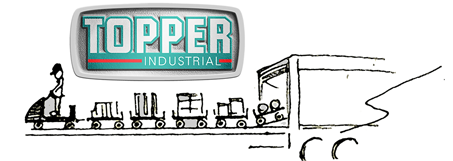Effective material flow in an assembly facility leads to reduced material handling costs and increased productivity. Topper Industrial has been committed to improving the flow of materials for an assembly facility by supplying custom material handling equipment that receives supplied parts through receiving docks and transfers the parts to material storage locations and then to part usage locations. The locations of the receiving docks, storage locations, and line locations are predetermined, but the assignment of parts to dock locations, storage locations, and the material flow paths through the facility are decision variables.
With line-side delivery, carts design decisions such as the dock strategy employed, and the configuration of the storage areas lead to additional decision variables. The goal is to reduce overall material handling costs by effectively receiving, storing, and transferring the material from loading docks to line locations using cart delivery. The Topper team runs various cart delivery routes and scenarios showing an improvement in the material handling costs of nearly ten percent as compared to the status quo.
Since the benefits of just-in-time (JIT) production philosophy were introduced, many production planners are viewing scheduling, machine idle time, and in-process inventory from a new perspective. Where once optimum levels of inventories, minimum machine idle time, and large batch sizes were thought to be measures of an efficient production system, now reducing set-up times, reducing batch sizes, and achieving zero inventory levels are economically sound procedures.
Efficient pick-up and drop-off using cart delivery keeps material moving. JIT production techniques can be thought of as “pulling” the in-process materials through the processing system. This means that as component parts are used to build units at assembly, a “signal” is sent to the previous processing station to have the quantity of assembled component parts replaced. This process then proceeds backward against the flow of production, through each previous processing station, creating the sense that the parts are being “pulled” through the system. This is unlike the typical manufacturing system where a demand is forecast, or an order placed, and the lot sizes for each component are determined for the first process station. The batches are then “pushed” forward through their processing stations to the finished state. Cart delivery is there from start to finish being able to follow one route doing the same value added work as that produced by upwards of twenty routes used to move material via fork lifts and fork trucks.
In automated flow production facilities which have a job shop orientation, a method for taking advantage of JIT techniques is the synchronization of processing stations. As in flow shop assembly lines where the assembly stations are balanced to keep the system operating smooth, automated processing systems and job shops can operate in a similar fashion. Production systems can use synchronization to avoid bottlenecks and keep the automated flow of material moving smoothly. Job shops, which cannot depend on relatively flat production demands, could at least synchronize the start and/or end of serial processing stations and the convergence of component arrival times at assembly.
Flow shops use balancing techniques to determine efficient labor and equipment requirements to keep the production system moving smoothly or in a synchronous mode. Other production systems can be designed to have activity times of the various processing station elements (load/unload, fixturing parts, process parts, etc.) adjusted to achieve synchronization.
Topper engineers find material handling equipment solutions with benefits based on the location, size, weight, frequency, and space available for each production and manufacturing application. Topper Industrial holds many patents which specialize in moving parts, taking packaging, ergonomics, and part presentation each essential to material handling equipment that promotes effective material flow. The primary goal of Topper Industrial is to safely move material using cart delivery and compatible equipment in a manner which is most efficient both in saving money and ensuring safety.
Material flow can be measured by reducing a single touch. Innovation in production assembly keeps employees safe, prevents errors, and keeps production material and processes moving.
About Topper Industrial
For more than twenty years, Topper Industrial, (www.topperindustrial.com) based just outside of Milwaukee, WI, has been a leader in the material handling equipment industry. The company’s product roster features industrial carts, conveyors, lifts, lifts & tilts, shipping racks, containers, casters, and cart components. From mother-daughter carts to quad steer carts to tilt carts and rotate carts, Topper’s material handling solutions make delivering material line side more effective through more efficient practices. Topper Industrial has a team of experienced professional experts able to assess and provide the right product for all material handling equipment requirements.
Topper Industrial is a proud member of MHI. Follow on Twitter @TopperInd or on LinkedIn.

